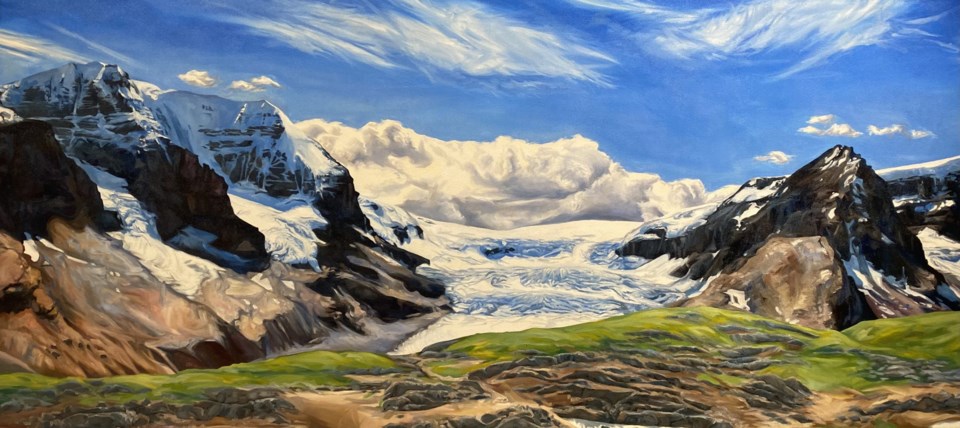Scott Hayes, Local Journalism Initiative Reporter | [email protected]
A new exhibit hopes to shed more light on what glaciers are, what they do and why itÔÇÖs so important to prevent them from shrinking any more.
ÔÇťOur Vanishing GlaciersÔÇŁ opens this weekend at the Jasper-Yellowhead Museum.
The title was borrowed from the book ÔÇťOur Vanishing Glaciers: The Snows of Yesteryear and the Future Climate of the Mountain WestÔÇŁ by Robert William Sandford of Canmore. Sandford, the Global Water Futures Chair with the United Nations UniversityÔÇÖs Institute for Water, Environment, and Health, helped the museum in the development of the exhibit.
Sandford said researchers study glaciers because they offer a reflection of freshwater on a continental scale, but itÔÇÖs about more than that.
ÔÇťOne of the things that weÔÇÖre seeing more and more in our research is the extent to which ice has thermoregulated a climate that has remained relatively stable since the end of the last Ice Age,ÔÇŁ he said.
ÔÇťThatÔÇÖs coming to an end. Thirty years ago, we lived in the Holocene. We live now in a very different time: the Anthropocene.ÔÇŁ
While global warming has caused a significant amount of glacier retreat, there is hope for the future, the exhibit explains, but that hope relies on cooler heads ÔÇô and climates ÔÇô to prevail.
To help that along, the exhibit couples artwork to inspire the viewers and science to motivate their minds. The glacier-inspired nine artworks were provided by Mountain Galleries, which collaborated on the exhibit as did Guardians of the Ice, ÔÇťa multidisciplinary art project attending to the Columbia Icefield and all that it means,ÔÇŁ according to its website.
Art, Sandford continued, can certainly elucidate the issue and give us hope, but something he was concerned about in his work is that hope is not something that can be given: you have to earn it.
That means people have to start really listening to the glaciers.
ÔÇťOne of the engaging ways this exhibition approaches this is it asks us what the disappearing ice is trying to tell us. When you start thinking about that, thatÔÇÖs the door opener that reaches inward. Also, it does it in ways that are completely non-scientific. TheyÔÇÖre aesthetic.ÔÇŁ
ÔÇťOur Vanishing GlaciersÔÇŁ brings viewers in with art, but itÔÇÖs the science that makes them stick around. The exhibit involves other climate experts and peer-reviewed sources to provide its information, making the show a must-see for anyone who either loves good art or is concerned about the state of the environment.
For instance, the exhibitÔÇÖs panels tell us that EarthÔÇÖs natural carbon cycle has changed dramatically as a result of global warming caused by the industrial boom of the last two centuries.
ÔÇťHumans are pumping carbon dioxide into a balanced cycle, thus upsetting its equilibrium,ÔÇŁ it stated.
ÔÇťAll that CO2 entering the atmosphere is causing the mountain ice to melt at a rate never before seen. Consider CanadaÔÇÖs spring melt, when the snowpack thaws and fills our rivers with water.ÔÇŁ
The spring melt occurs earlier every year because of this, resulting in disruptions to all human enterprise in agriculture, fisheries and recreation, not to mention our emotional and aesthetic connection to water.
The exhibit has been in the works for years and was prompted by the museum and the galleryÔÇÖs mutual interest in a collaboration. That was fostered especially as many of the museumÔÇÖs staff had previously worked with Jim Elzinga, founder of Guardians of the Ice.
ÔÇťI think, especially just coming out of COVID as well, there was a need for something hard hitting and emotional, but also to spin it in a bit of a positive light, because we were all quite impacted by what was happening in the world at the time,ÔÇŁ said Maggie McKenney, summer student curator at the museum.
ÔÇťThis is an emotional topic, and it's hard hitting, but they're really trying to use art as a tool to spin it in a more positive light to get people to communicate with people. I think oftentimes when people are hit by the truth of climate change, they just shut down.ÔÇŁ
Brooklyn Rushton is the co-ordinator of the Jasper chapter of Protect Our Winters, a group of climate enthusiasts dedicated to saving the natural environment.
Rushton described how important glaciers were to mountain culture, livelihoods and ecosystems.
ÔÇťWe hope that this exhibit will help to create an emotional connection between people and change in our surrounding landscape, while inspiring us all to take collective action in shaping a more sustainable future in Jasper.ÔÇŁ
Sandford couldnÔÇÖt agree more. He spoke about the Global Water Initiative, a research program that ended in 2017 but whose outcomes are just now maturing. He said they have a lot to say about glacial recession and changes in snowpack duration and cover.
ÔÇťI think youÔÇÖre going to find some results that are going to affirm the need for many more exhibitions and much more interface with art and ethics and all sorts of intelligences as that research unfolds. [Glacial recession is] happening way faster ÔÇô 20 to 30 years faster ÔÇô than anybody projected.ÔÇŁ
The exhibit runs until Oct. 2. McKenney noted that some special presentations and events are still being planned to tie in with it.
Local Indigenous glacier expert Theresa Westhaver will also be a guest speaker.




